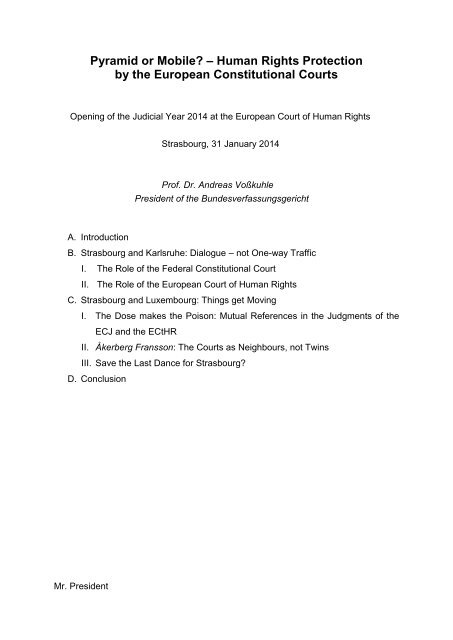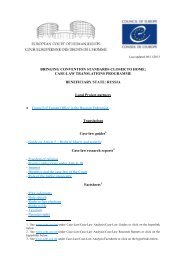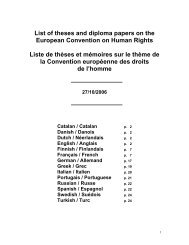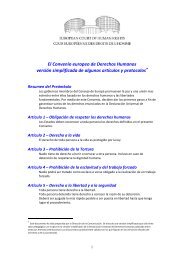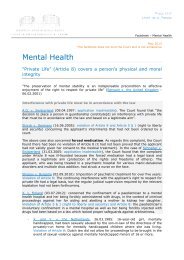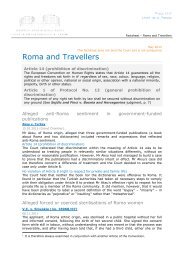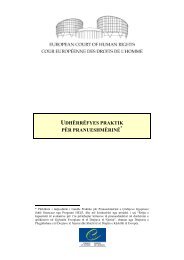Speech by Andreas Voßkuhle - European Court of Human Rights
Speech by Andreas Voßkuhle - European Court of Human Rights
Speech by Andreas Voßkuhle - European Court of Human Rights
Create successful ePaper yourself
Turn your PDF publications into a flip-book with our unique Google optimized e-Paper software.
Pyramid or Mobile? – <strong>Human</strong> <strong>Rights</strong> Protection<br />
<strong>by</strong> the <strong>European</strong> Constitutional <strong>Court</strong>s<br />
Opening <strong>of</strong> the Judicial Year 2014 at the <strong>European</strong> <strong>Court</strong> <strong>of</strong> <strong>Human</strong> <strong>Rights</strong><br />
Strasbourg, 31 January 2014<br />
Pr<strong>of</strong>. Dr. <strong>Andreas</strong> <strong>Voßkuhle</strong><br />
President <strong>of</strong> the Bundesverfassungsgericht<br />
A. Introduction<br />
B. Strasbourg and Karlsruhe: Dialogue – not One-way Traffic<br />
I. The Role <strong>of</strong> the Federal Constitutional <strong>Court</strong><br />
II. The Role <strong>of</strong> the <strong>European</strong> <strong>Court</strong> <strong>of</strong> <strong>Human</strong> <strong>Rights</strong><br />
C. Strasbourg and Luxembourg: Things get Moving<br />
I. The Dose makes the Poison: Mutual References in the Judgments <strong>of</strong> the<br />
ECJ and the ECtHR<br />
II. Åkerberg Fransson: The <strong>Court</strong>s as Neighbours, not Twins<br />
III. Save the Last Dance for Strasbourg?<br />
D. Conclusion<br />
Mr. President
- 2 -<br />
Dear colleagues<br />
Ladies and Gentlemen,<br />
it is a true Honour for me to join you today for the opening <strong>of</strong> the judicial year, and I<br />
thank you very much for the invitation to take part in this important occasion.<br />
A. Introduction<br />
The title <strong>of</strong> my speech is “Pyramid or Mobile? – <strong>Human</strong> <strong>Rights</strong> Protection <strong>by</strong> the<br />
<strong>European</strong> Constitutional <strong>Court</strong>s”. Contrary to what “pyramid or mobile” might suggest,<br />
I am not going to talk about telecommunications in Egypt. By “mobile”, I mean – inspired<br />
<strong>by</strong> the former judge Renate Jaeger – a kinetic sculpture which consists <strong>of</strong> an<br />
ensemble <strong>of</strong> balanced parts that can move but is connected through strings or wire. 1<br />
When I use the word “pyramid”, I refer to a fixed geometric structure that has a base<br />
and a top.<br />
In the following, I will try to establish which <strong>of</strong> these two images is more suitable<br />
to capture characteristics <strong>of</strong> the <strong>European</strong> constitutional courts in their protection <strong>of</strong><br />
human rights. In order to do this, we need to examine some features <strong>of</strong> the interaction<br />
<strong>of</strong> these courts and <strong>of</strong> their respective catalogues <strong>of</strong> rights. The system <strong>of</strong> human<br />
rights protection in Europe is a topic which I already highlighted in past speeches.<br />
However, we will see that the “Verbund” is a living and changing organism that deserves<br />
to be observed, accompanied and re-balanced in its constant evolution. In the<br />
following, I will approach this very complex topic <strong>by</strong> making just a few brief observations.<br />
B. Strasbourg and Karlsruhe: Dialogue –<br />
not One-way Traffic<br />
Ladies and Gentlemen,
- 3 -<br />
If you look at the parts <strong>of</strong> a mobile for some time, you will realise that they are not<br />
revolving around their own axes, but are constantly engaging in an imaginary dialogue,<br />
induced <strong>by</strong> the movements <strong>of</strong> the other parts. The ECtHR and the FCC <strong>of</strong><br />
Germany – like all national constitutional courts – also depend on a permanent dialogue,<br />
in order to coordinate the protection <strong>of</strong> fundamental rights in a multilevel system.<br />
How does the interplay <strong>of</strong> the <strong>European</strong> Convention on <strong>Human</strong> <strong>Rights</strong> and the<br />
German Constitution work? Which concessions do the ECtHR and the FCC have to<br />
make in order to coordinate their work? Where might corrections be necessary?<br />
To ease the suspense: A strictly hierarchical – in other words: pyramidal – approach<br />
would not fit the characteristics <strong>of</strong> a “Verbund” <strong>of</strong> <strong>European</strong> Constitutional<br />
<strong>Court</strong>s.<br />
I. The Role <strong>of</strong> the Federal Constitutional <strong>Court</strong><br />
First <strong>of</strong> all, let us examine the “mobile <strong>of</strong> institutions” from the point <strong>of</strong> view <strong>of</strong> the<br />
FCC. The Basic Law is not only open towards <strong>European</strong> and international law, it is<br />
also specifically open towards human rights. The Basic Law places the FCC, as well<br />
as all other constitutional bodies, at the service <strong>of</strong> international human rights. Our<br />
recent case law shows that these words do not merely represent constitutional poetry.<br />
In May 2011, subsequent to your decision in M. v. Germany <strong>of</strong> December 2009, 2<br />
the FCC delivered a judgment concerning preventive detention in Germany 3 . Two<br />
aspects <strong>of</strong> this judgment prove the FCC´s openness towards human rights. First, the<br />
FCC chose to apply national procedural rules flexibly to avoid another breach <strong>of</strong> the<br />
Convention. Despite a former decision declaring the provisions on preventive detention<br />
constitutional, which, under German law, generally constitutes a procedural bar<br />
against the admissibility <strong>of</strong> new proceedings, the FCC considered the new constitutional<br />
complaints admissible with regard to the decision in M. v. Germany. 4 And secondly,<br />
the FCC stressed that the Convention has to be thoroughly considered at an<br />
early stage in the context <strong>of</strong> the receiving constitutional system. Although in Germany,<br />
the <strong>European</strong> Convention on <strong>Human</strong> <strong>Rights</strong> does not have the same rank as the
- 4 -<br />
Constitution, it does have significance under our constitutional law. For the FCC, it is<br />
an important guide to interpretation in determining the content and scope <strong>of</strong> fundamental<br />
rights and constitutional guarantees <strong>of</strong> the Basic Law.<br />
As you can see, the FCC accepts impulses from Strasbourg and is able to remedy<br />
breaches <strong>of</strong> the Convention already on a national level – there<strong>by</strong> providing relief<br />
to the caseload <strong>of</strong> the ECtHR. We are pleased that in the Kronfeldner case, 5 the ECtHR<br />
recently welcomed our approach <strong>of</strong> interpreting the Basic Law in in the light <strong>of</strong><br />
the Convention, as this manifests the intensive dialogue between the two courts.<br />
However, acceptance <strong>of</strong> the Convention should not be mistaken for strict obedience.<br />
The Basic Law has certain limits when it comes to its interpretation with regard<br />
to international law. The comparative interpretation has to be methodically justifiable<br />
and compatible with the Basic Law’s core values (Art. 79 sec. 3 GG). 6 In addition, the<br />
interpretation must not ‘– according to Art. 53 <strong>of</strong> the Convention – compromise the<br />
standard <strong>of</strong> protection <strong>of</strong> fundamental rights provided <strong>by</strong> the Basic Law. 7 Occasionally,<br />
the Basic Law guarantees a higher level <strong>of</strong> protection. This is illustrated <strong>by</strong> two<br />
recent cases, one <strong>by</strong> the ECtHR, the other <strong>by</strong> the FCC, that were delivered on the<br />
same day. The ECtHR´s judgment in X and others v. Austria <strong>of</strong> 19 February 2013<br />
concerned the right <strong>of</strong> unmarried same-sex couples to second-parent adoption, 8<br />
while the FCC´s judgment concerned the non-admission <strong>of</strong> successive adoption <strong>by</strong><br />
registered civil (same-sex) partners 9 . Whereas the ECtHR held that there had been<br />
no violation <strong>of</strong> Art. 14 in conjunction with Art. 8 <strong>of</strong> the Convention when the applicants’<br />
situation was compared with that <strong>of</strong> a married couple 10 , the FCC found that the<br />
exclusion <strong>of</strong> successive adoption <strong>by</strong> registered civil partners violated the general<br />
principle <strong>of</strong> equality before the law (Art. 3 sec. 1 GG) 11 .<br />
II.<br />
The Role <strong>of</strong> the <strong>European</strong> <strong>Court</strong> <strong>of</strong> <strong>Human</strong> <strong>Rights</strong><br />
And what does the basis <strong>of</strong> a cooperation on the part <strong>of</strong> the <strong>European</strong> <strong>Court</strong> <strong>of</strong><br />
<strong>Human</strong> <strong>Rights</strong> look like? My opinion is: The <strong>European</strong> <strong>Court</strong> <strong>of</strong> <strong>Human</strong> <strong>Rights</strong> is not a<br />
lonesome fighter either, but a strong player in a team. It does not render national<br />
constitutional courts unnecessary, but takes their existence as a precondition. To
- 5 -<br />
keep to my picture <strong>of</strong> the mobile <strong>of</strong> institutions: Each element is necessary to keep<br />
the balance. Otherwise one lonesome pendulum would orbit around itself.<br />
In order to perform this balancing act, the ECtHR is, as an international court,<br />
confronted with the task <strong>of</strong> defining the minimum standard <strong>of</strong> fundamental rights protection.<br />
This minimum standard can be accepted <strong>by</strong> national authorities and courts <strong>of</strong><br />
all Member States, without giving up the plurality <strong>of</strong> national fundamental rights provisions.<br />
At the same time, when it comes to the effective enforcement and the dynamic<br />
development <strong>of</strong> the Convention, the ECtHR increases its acceptance <strong>by</strong> being considerate<br />
in its handling <strong>of</strong> the national “inheritance” – traditions that have evolved<br />
over a long time. The Grand Chamber judgment <strong>of</strong> Lautsi and Others v. Italy <strong>of</strong> 18<br />
March 2011 is a fine example <strong>of</strong> judicial self-restraint. In the judgment, the Chamber<br />
stated that the decision whether crucifixes should be present in classrooms was a<br />
matter falling within the margin <strong>of</strong> appreciation <strong>of</strong> the respective State party. Thus, it<br />
took into account the statements <strong>of</strong> the Italian government, which had put forward<br />
that the presence <strong>of</strong> crucifixes in classrooms had not only cultural significance but<br />
also an identity-creating effect. 12 Furthermore, the ECtHR fortunately respects the<br />
margin <strong>of</strong> appreciation where a case raises sensitive moral or ethical issues, on<br />
which no consensus has been reached between the Member States. In this regard,<br />
one example is the case <strong>of</strong> Stuebing, in which the ECtHR held that the applicant’s<br />
conviction <strong>by</strong> German courts for an incestuous relationship did not violate Art. 8 <strong>of</strong><br />
the Convention. And not to forget the Countryside Alliance case, in which the ECtHR<br />
decided that the various bans on fox hunting and the hunting <strong>of</strong> other wild mammals<br />
with dogs in the United Kingdom did not amount to a violation <strong>of</strong> the Convention. 13<br />
Even Lord Bingham´s, well, very British argument to justify the ban, namely the suggestion,<br />
I quote, “that the British mind more about their animals than their children” 14 ,<br />
was apparently regarded as falling within the margin <strong>of</strong> appreciation. 15<br />
As you know, the Council <strong>of</strong> Europe has, in the meantime, submitted the Protocol<br />
No. 15 to the Convention, which incorporates into the preamble a reference to the<br />
principle <strong>of</strong> subsidiarity and the doctrine <strong>of</strong> the margin <strong>of</strong> appreciation. 16 This is a major<br />
contribution to the rebalancing <strong>of</strong> our mobile <strong>of</strong> institutions. The more the implementation<br />
<strong>of</strong> the Convention is deferred to the national authorities and courts, the<br />
better can the ECtHR – in light <strong>of</strong> its limited resources – focus on its role as the<br />
guardian <strong>of</strong> a common core standard <strong>of</strong> human rights. At the same time, as my Bel-
- 6 -<br />
gian colleague Bossuyt recently pointed out, some questions – especially those concerning<br />
positive obligations – are best left at home with the courts who are familiar<br />
with the national community’s economic, social and cultural environment. 17 Extending<br />
the <strong>Court</strong>´s jurisdiction to economic and social rights beyond a core standard could<br />
deprive human rights <strong>of</strong> their universality, since the above mentioned rights are unattainable<br />
<strong>by</strong> many countries. 18<br />
C. Strasbourg and Luxembourg: Things get Moving<br />
Strasbourg is not only intimately connected with the national courts. It is also<br />
closely linked with the other <strong>European</strong> court, the ECJ in Luxembourg – linked in a<br />
way we could call a “relationship in motion”. In this relationship, a representative <strong>of</strong><br />
a national constitutional court is, <strong>of</strong> course, not a direct protagonist. Nonetheless, in<br />
the logic <strong>of</strong> the mobile image, movement <strong>by</strong> other elements <strong>of</strong> the mobile necessarily<br />
have repercussions on the system as a whole. Thus, national courts are more than<br />
just casual <strong>by</strong>standers. So, from the viewpoint <strong>of</strong> an interested observer, I will briefly<br />
point out three ties between the two courts that already exist or are about to emerge.<br />
I. The Dose makes the Poison: Mutual References in the Judgments <strong>of</strong> the<br />
ECJ and the ECtHR<br />
The first thing that seems remarkable to me: The way in which Luxembourg and<br />
Strasbourg courts make mutual use <strong>of</strong> each other’s frame <strong>of</strong> reference. To draw upon<br />
other sources <strong>of</strong> human rights texts and jurisprudence is, <strong>of</strong> course, an excellent way<br />
to achieve the necessary coherence between overlapping human rights catalogues.<br />
But as always: The dose makes poison <strong>of</strong> what is normally a remedy. In mutual references<br />
to the respective texts there are certain pitfalls to be avoided. A Strasbourg<br />
<strong>Court</strong> that aims to be the first in shaping the interpretation <strong>of</strong> a Charter provision<br />
would be out <strong>of</strong> place. The same would apply to the Luxembourg <strong>Court</strong> using the<br />
Convention in order to override the restricted scope <strong>of</strong> application <strong>of</strong> the Charter.<br />
Luckily, these pitfalls appear largely theoretical. Recently, some scholars criticised<br />
a significant decrease in the ECJ’s citation <strong>of</strong> the Convention text and jurisprudence<br />
and cautioned against an isolated interpretation <strong>of</strong> the Charter. 19 My personal guess
- 7 -<br />
would be that with the accession <strong>of</strong> the EU to the Convention, the convergence between<br />
the human rights instruments will increase again.<br />
II.<br />
Åkerberg Fransson: The <strong>Court</strong>s as Neighbours,<br />
not Twins<br />
Secondly and even more remarkably, one can witness<br />
a certain “rapprochement” between the roles <strong>of</strong> the two courts.<br />
To put it in a nutshell with the words <strong>of</strong> a law pr<strong>of</strong>essor, the Luxembourg <strong>Court</strong> has<br />
“evolved from being a tribunal concerned primarily with economic matters, to one with<br />
a much wider range <strong>of</strong> jurisdiction which is now explicitly tasked with enforcing human<br />
rights”. 20 This shift in its nature, <strong>of</strong> course, raises new questions as to the respective<br />
functions <strong>of</strong> the Strasbourg and Luxembourg courts. In my understanding,<br />
the mandates <strong>of</strong> the courts should not blur, but be kept quite distinct. Whereas Strasbourg,<br />
according to Art. 53 <strong>of</strong> the Convention, sets the minimum level <strong>of</strong> human rights<br />
protection in all <strong>of</strong> Europe, the ECJ shall ensure that in the interpretation and application<br />
<strong>of</strong> the EU Treaties the law is observed (Art. 19 § 1 Treaty on <strong>European</strong> Union).<br />
Lately, the Åkerberg Fransson decision 21 swept like a blast – or even like a storm –<br />
through the mobile I sketched. In the aftermath <strong>of</strong> “Åkerberg”, it might be important to<br />
stress the following: As much as a uniformly high human rights standard in Europe is<br />
desirable, it is not the task <strong>of</strong> the Luxembourg <strong>Court</strong> to safeguard it internationally,<br />
but that <strong>of</strong> Strasbourg and the ECtHR.<br />
III.<br />
Save the Last Dance for Strasbourg?<br />
Thirdly and finally, the most striking <strong>of</strong> the ongoing transformations is the emerging<br />
formalisation <strong>of</strong> the relationship between the two <strong>Court</strong>s.<br />
The accession <strong>of</strong> the EU to the Convention will reshape the institutional architecture.<br />
<strong>European</strong> laws and judgments will be subjected to the jurisdiction <strong>of</strong> the Strasbourg<br />
<strong>Court</strong> – an operation which our host, the President <strong>of</strong> the ECtHR Dean Spielmann,<br />
rightly praises as a high point <strong>of</strong> modern Europe’s commitment to human rights. 22 For<br />
the accession to operate smoothly, it might once more be helpful to set the pyramid
- 8 -<br />
model aside and to concentrate on the mobile instead. Becoming part <strong>of</strong> the Convention<br />
should not be thought <strong>of</strong> in terms <strong>of</strong> hierarchy, but in terms <strong>of</strong> specialisation.<br />
Strasbourg does not gain authority to bindingly assess the validity or the right interpretation<br />
<strong>of</strong> EU law. 23 Instead, the accession means no more – and no less – than<br />
the external involvement <strong>of</strong> a specialised international human rights court. An involvement<br />
that will enhance legitimacy and credibility for the system <strong>of</strong> human rights<br />
protection as a whole.<br />
D. Conclusion<br />
Ladies and Gentlemen, we have seen that <strong>European</strong> human rights protection can<br />
be better understood if pictured not as a pyramid, but as a mobile. We have also established<br />
that a mobile, in order to work, quite literally comes with strings attached.<br />
The parts <strong>of</strong> the system, we, the <strong>European</strong> Constitutional <strong>Court</strong>s, have to go about<br />
our task with sensitivity in order to preserve our balance. After all, we do not want the<br />
mobile and its strings to turn into a spider’s web in which those who seek protection<br />
get entangled.<br />
There is a citation <strong>by</strong> Alexander Calder, the father <strong>of</strong> the mobile as an art medium.<br />
He noted: “when everything goes right, a mobile is a piece <strong>of</strong> poetry that dances<br />
with the joy <strong>of</strong> life and surprises.” I think even the visionary drafters <strong>of</strong> our respective<br />
human rights catalogues would be surprised <strong>by</strong> how dynamic the multilevel human<br />
rights protection in Europe has proved to be. As far as dancing is concerned, this<br />
might not be compatible with the character <strong>of</strong> a solemn hearing. But I am very much<br />
looking forward to interesting, animated and fruitful exchanges with you tonight and in<br />
the future.<br />
Thank you very much for your attention!<br />
1 Interview in “The Economist” 26 March 2009, p. 34.<br />
2 <strong>European</strong> <strong>Court</strong> <strong>of</strong> <strong>Human</strong> <strong>Rights</strong>, Judgment <strong>of</strong> 17 December 2009, Application no. 19359 (M. v.<br />
Germany).<br />
3 Decisions <strong>of</strong> the Federal Constitutional <strong>Court</strong> (Entscheidungen des Bundesverfassungsgerichts -<br />
BVerfGE) 128, 326 .<br />
4 Cf. BVerfGE 128, 326 et seq.
- 9 -<br />
5 <strong>European</strong> <strong>Court</strong> <strong>of</strong> <strong>Human</strong> <strong>Rights</strong>, Judgment <strong>of</strong> 19 January 2012, Application no. 21906/09 (Kronfeldner<br />
v. Germany), para 59; see also Judgment <strong>of</strong> 19 April 2012, Application no. 61272/09 (B. v.<br />
Germany), para 44 et seq., 98.<br />
6 Cf. BVerfG loc. cit. p. 371.<br />
7 Cf. BVerfG loc. cit.<br />
8 <strong>European</strong> <strong>Court</strong> <strong>of</strong> <strong>Human</strong> <strong>Rights</strong>, Judgment <strong>of</strong> 19 February 2013, Application no. 19010/07 (X and<br />
others v. Austria).<br />
9 BVerfG, Judgment <strong>of</strong> the First Senate <strong>of</strong> 19 February 2013 – 1 BvL 1/11 –, NJW (Neue Juristische<br />
Wochenschrift) 2013, p. 847.<br />
10 <strong>European</strong> <strong>Court</strong> <strong>of</strong> <strong>Human</strong> <strong>Rights</strong>, Judgment <strong>of</strong> 19 February 2013, Application no. 19010/07 (X and<br />
others v. Austria), paras 105 et seq.<br />
11 BVerfG, Judgment <strong>of</strong> the First Senate <strong>of</strong> 19 February 2013 – 1 BvL 1/11 –, NJW 2013, p. 847 (855).<br />
12 Cf. <strong>European</strong> <strong>Court</strong> <strong>of</strong> <strong>Human</strong> <strong>Rights</strong>, Judgment <strong>of</strong> 18 March 2011, Application no. 30814/06 (Lautsi<br />
and Others v. Italy), paras. 67 et seq.<br />
13 <strong>European</strong> <strong>Court</strong> <strong>of</strong> <strong>Human</strong> <strong>Rights</strong>, Judgment <strong>of</strong> 24 November 2009, Application no. 16072/06<br />
(Friend v. United Kingdom) and 27809/08 (Countryside Alliance and others v. United Kingdom).<br />
14 R (Countryside Alliance) v. Attorney General [2008] 1 AC 719, para 37.<br />
15 Cf. Hale, Argentoratum Locutum: Is Strasbourg or the Supreme <strong>Court</strong> Supreme?, H.R.L.R. 12<br />
(2012), p. 65 (72).<br />
16 Art. 1 <strong>of</strong> the “Protocol No. 15 amending the Convention for the Protection <strong>of</strong> <strong>Human</strong> <strong>Rights</strong> and<br />
Fundamental Freedoms”.<br />
17 Bossuyt, Judicial activism in Strasbourg, to appear in print, manuscript p. 17.<br />
18 CF. Bossuyt, Judicial activism in Strasbourg, to appear in print, manuscript p. 17<br />
19 De Búrca, After the EU Charter <strong>of</strong> Fundamental <strong>Rights</strong>: The <strong>Court</strong> <strong>of</strong> Justice as a <strong>Human</strong> <strong>Rights</strong><br />
Adjudicator?, Maastricht Journal <strong>of</strong> <strong>European</strong> and Comparative Law 20 (2013), p. 168 (173-176); Polakiewicz,<br />
EU law and the ECHR: Will the <strong>European</strong> Union’s Accession square the Circle?, E.H.R.L.R.<br />
2013, p. 592 (594 -597).<br />
20 De Búrca, After the EU Charter <strong>of</strong> Fundamental <strong>Rights</strong>: The <strong>Court</strong> <strong>of</strong> Justice as a <strong>Human</strong> <strong>Rights</strong><br />
Adjudicator?, Maastricht Journal <strong>of</strong> <strong>European</strong> and Comparative Law 20 (2013), p. 168 (171).<br />
21 ECJ (Grand Chamber), Judgment <strong>of</strong> 26 February 2013, C-617/13 – Åkerberg Fransson.<br />
22 Spielmann, Menschenrechte in Europa, <strong>Speech</strong> at the Bundesverfassungsgericht on 9 April 2013:<br />
“Krönung des Engagements des modernen Europas für die Menschenrechte”.<br />
23 See Torres Pérez, Too many voices? The prior involvement <strong>of</strong> the <strong>Court</strong> <strong>of</strong> Justice <strong>of</strong> the <strong>European</strong><br />
Union, <strong>European</strong> Journal <strong>of</strong> <strong>Human</strong> <strong>Rights</strong> 4 (2013), p. 565 (583).


